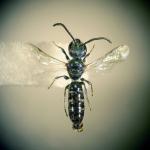Lasioglossum scoticum EBMER 1970; Lasioglossum hibernicum EBMER 1970;
This species was formerly referred to in the British and Irish literature either as a form of Lasioglossum smeathmanellum, with the female gaster mostly black and not metallic (Stelfox 1927), or as a species without a name (R C L Perkins 1935). This neglected species was later considered to consist of two allied, but undescribed species, by A W Ebmer. He described them under the names Lasioglossum scoticum (described from Scotland, but clearly known also from England and Wales) and L. hibernicum (described from Ireland) (Ebmer 1970). Later he considered them to be subspecies of L. cupromicans (Pérez 1903) (Ebmer 1976).
L. cupromicans and L. smeathmanellum form a species-pair in Britain with a largely allopatric distribution, the former species totally replacing L. smeathmanellum in Scotland and Ireland, and mainly so at higher altitudes and on moorland in north Wales, northern England, the Midlands and the south-west peninsula (e.g. Dartmoor). Was widely distributed but often rare and local in Ireland: Cork, Waterford, Clare, Tipperary, Wexford, Wicklow, Dublin and Mayo (Stelfox 1927), but there have been widespread recent records.
This species is not regarded as being scarce or threatened.
Woodland, moors and coastal sites. Occasionally found in other habitats.
Females from late April to the end of October, males from mid August to the beginning of October.
In Charnwood Forest, Leicestershire, Spooner (1946) found the species nesting in the earth crevices of stone walls and rocks, and also, in company with L. smeathmanellum, round the stonework of a farm building. Social organisation has not been recorded.
Cat's-ear species (Hypochoeris sp.), cinquefoil species (Potentilla sp.), hawkbit species (Leontodon sp.), hawk's-beard species (Crepis sp.), heather (Calluna vulgaris), sheep's-bit (Jasione montana), stonecrop species (Sedum), turnip (Brassica rapa var. rapa) and thistle species (Cirsium and Carduus spp.). P. Harvey (pers. comm.) has suggested that this bee species may have a close association with the flowers of rosebay willowherb (Epilobium angustifolium) in lowland Britain.
Proofed: January 2012


